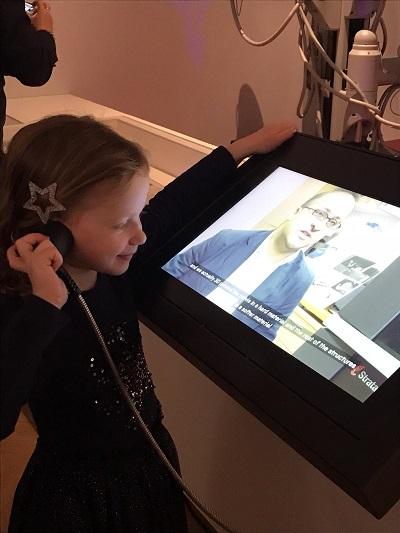Guy's and St Thomas' exhibits in new Science Museum galleries
Monday 9 December 2019

Face masks used for radiotherapy and 3D printed models from a pioneering kidney transplant are on show at London’s Science Museum, after being donated by Guy’s and St Thomas’.
Both medical breakthroughs are in a new exhibition Medicine: The Wellcome Galleries that features ‘the most significant medical collections in the world’. The exhibits are among three thousand on show and explore our relationship with medicine and health through more than 500 years of history.
Surgeons at Guy’s Hospital pioneered the use of 3D printing to support the transplant that Lucy Boucher had in November 2015, after her father Chris donated his kidney to her.
Models of Lucy’s abdomen and Chris’ kidney were made to help surgeons accurately plan the complex surgery and to minimise any risks. This meant that any issues involved with transplanting an adult sized donor kidney into a child’s small abdomen could be identified in advance.
It was the first time in the world that 3D printing was used to assist kidney transplant surgery involving an adult donor and child recipient.
The project was masterminded by Mr Pankaj Chandak, transplant registrar at Guy’s and St Thomas’. The 3D printed models were created using CT and MRI scans to represent the true-to-life size and shape of the donor's kidney and the child's abdominal organs and blood vessels.
The team, which used a new 3D printer housed at St Thomas’ Hospital that was purchased thanks to a grant awarded by Guy’s and St Thomas’ Charity, were recently reunited with Lucy in the gallery.
Nizam Mamode, consultant transplant surgeon at Guy’s and St Thomas’, said: “It’s a very proud moment. This is recognition that the work we have done is of interest to the public and scientific community. We are very proud as a team to see the models there.
“We were particularly pleased to see Lucy at the exhibition and see how well she is doing.”
Commenting on the use of 3D printed models for the ground-breaking kidney transplant, Selina Hurley, the Science Museum’s Curator of Medicine, said:
“These models represent a powerful example of one family’s story of a life-changing transplant operation. We’re thrilled that they are now here on display at the Science Museum in the world’s largest medical galleries. Thanks to these objects, audiences from across the world will be able to discover more about the potential uses of 3D printing technology in surgery and medicine.”
An exhibit to highlight radiotherapy as a cancer treatment is also featured to show the human experience of medicine and technology. At the centre of this are two facemasks – including an adult mask from Guy’s - to hold the head still so that therapy can be given precisely.
Two patients treated at Guy’s Cancer shared their experiences of treatment with primary chemo-radiation – a combination treatment of both radiotherapy and chemotherapy. A powerful voice recording by Roger Pebody, who is 48 and works for a HIV charity, recounting his experience of both cancer and the treatment with a mask is featured in one room. David Boyce, a 60-year-old bass player in rock band Grand Slam who underwent primary chemo-radiation to treat his head and neck cancer, also shares his story as part of the show.
Dr Mary Lei, consultant clinical oncologist at Guy’s and St Thomas’, said: “David lost his hair due to the treatment which as a rock musician is very unsettling! Thankfully it has fully grown back. It was touching that Roger and David gave up their time and shared their very personal experiences of radiotherapy treatment.
“I think it’s great for Guy’s to contribute to the exhibition and help explain what radiotherapy is and how it works. There are many people involved in supporting these patients through their treatment and we feel very proud as a team.”
Four statues by Thomas Cartwright, which were previously displayed at St Thomas’, are also in the exhibition. Known as ‘The Cripples’ and carved in 1681, the sculptures were innovative for showing typical patients at the time and were positioned around a stature of Edward the VI. They were in a façade around a courtyard entrance on the old St Thomas’ Hospital site in Southwark, which was one of the original five royal hospitals.
Last updated: March 2022
Contact us
Media enquiries
Phone: 020 7188 5577
Email: [email protected]